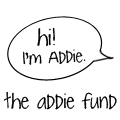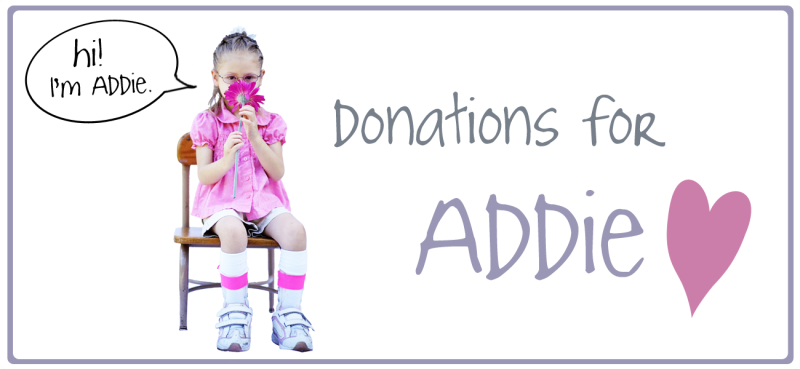Anyone who meets Addie can quickly identify that she is special. And not just because she wears braces on her legs and glasses and can't quite move like the other kids. You see it in her smile. In the way she brings out the best in others. She is sweet, unassuming, trusting, and kind. Addie embodies the very best humanity has to offer.
Addie was born with brain damage, a condition which was later officially diagnosed as
cerebral palsy with epilepsy. Her parents did not initially know there were any problems. The warning signs came quickly, however, as Addie failed to reach milestones – not rolling over, not controlling her extremities, not sitting up. And then came the seizures. They were hard to notice at first, because they seemed so similar to a baby's “startle reflex.” But Addie was 5 months old – too old to still be experiencing that. The seizures finally increased in intensity enough that Addie stopped breathing during one. And so the treatment began.
Her first round of medication was a traumatic treatment of ACTH, a powerful steroid-based medication meant to stop seizures. The side-effects were what made the treatment traumatic: weight gain, irritability, a high risk of infection. Addie became a prisoner for the 2 month treatment – a prisoner in her house (for fear of her catching an illness), and a prisoner in her mind (she reverted to an almost vegetative state during treatment).
After several neurology appointments, it was determined that the treatment had been a success, and Addie was taken off the medication. When she was 10 months old, she started therapy. Physical, occupational, educational, and speech therapists came to the house weekly to help Addie accomplish those things that came easily and naturally to other children. When therapy started, she could not crawl, babble, or even feed herself.
The treatments were physically and emotionally exhausting. Addie cried continually as she was constantly manipulated to learn how to move. Even the simplest things, like learning how to bring her two hands together or how to bring one hand to her mouth, required hours and hours of grueling therapy. While small improvements were celebrated, Addie's parents worried that they would never hear their first-born child call them “Mama” or “Dada.” Their grief was at times overwhelming.
But then Addie began making great strides. First, by learning sign language as a means of communication. By the time she was 2, after over a year of therapy, she was crawling. And shortly thereafter came her first words. Cerebral palsy does not affect a person's cognitive ability or intelligence, but the magnitude of the brain injury can prevent people from expressing the cognitive ability they actually possess. Such was the case with Addie. As soon as she was able to break past the barrier holding her back, her vocabulary exploded. She was soon speaking in sentences, and was even surpassing the language milestones for children her age.
Her physical impairments continued to seem almost insurmountable. But with the help of dedicated physical and occupational therapists, Addie was soon learning how to stand with the aid of a “stander.” As part of her daily therapy, she would practice standing each day, reading books, watching t.v., whatever her parents could do to distract her, so her legs would stretch and begin to strengthen enough to hold her weight. When the standing treatment was declared a success, she was fitted for leg braces and given a walker. But even with all the strides she was making, it was not clear if she would ever be able to walk on her own.
When she was about 2 ½, Addie learned to walk. Her first steps were met with much more than excited clapping or cheering from giddy parents. Those steps were the result of years of work, tears of frustration and joy, and many heartfelt and pleading prayers. She continued to surpass all expectations of her disability, proving she was capable of living a more “normal” life than her parents ever dreamed possible.
In the midst of all their success, Addie had another seizure. Her recovery was longer than anyone anticipated. It was feared that Addie would regress, and lose all the ground she had gained overcoming her disability. It also meant more trips to the neurologist, more invasive testing, more dangerous medication. But she bounced back, not appearing to have lost any physical or motor developments.
In April 2009, while visiting her grandparents out-of-state, Addie experienced her most severe seizures to date. They continued for hours, some lasting as long as 15 minutes. She was rushed to the emergency room, where she stopped breathing for herself. A breathing tube was inserted, and she was rushed away from her parents on a Life Flight to a nearby children's hospital. Her mom was afraid she would never see her daughter alive again. After two days of being in the ICU, Addie was soon stabilized and discharged, with a new regimen of anti-seizure medication to take, all with their own scary side-effects.
She has recovered fully from the ordeal, again showing no signs of regression in her development. But Addie and her family still have their battles. They are now facing astronomical medical bills, in part from the extensive treatments she received while being in an out-of-network hospital, and in part from her continuing treatments here at home as they continue to run tests and administer new medications.
Since cerebral palsy is incurable, this is something Addie will continue to struggle with. She will most likely need physical, if not other forms, of therapy for the rest of her life. Advances in neurological medicine brings hope, but it also brings more visits, tests, and expensive treatments. Her epilepsy further complicates things – each seizure requiring more tests, medication, and hospitalization, as well as the fear of regression, or worse.
Addie's family continues to seek avenues for financial and other means of support from wherever they can find it. We who are friends of Addie have seen their need and are taking their story to the public, asking for the worldwide community to help this precious family in their ongoing struggle to give Addie all the resources that are available to help her live the most “normal” life she can possibly live.
Addie
is special. She has a special mission to perform on this earth. Her sweet spirit has brought, and will continue to bring, hope and peace to all who come in contact with her.
Please help us by donating to her cause. We appreciate your generosity.












